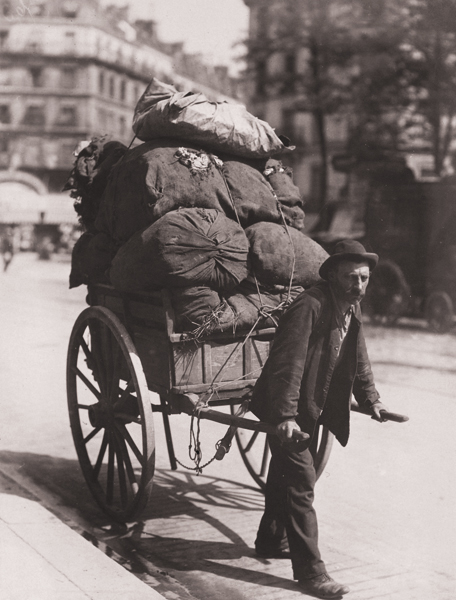My mother used to talk about the rag man. The rag man, often called the rag and bone man, or the rag picker, the pillawer, or the chiffonier, scoured cities, towns, and settlements for iron, cloth, food scraps, paper, and other recyclable materials. He sold these items to a dealer in these goods or sold them directly to manufacturers who could turn them into profitable commodities.
In Chamber's Journal of Popular Literature, No. 343, published Saturday, July 28, 1860, an article appeared called "Rags and Ragpickers in France." Here the ragpicker's life is described through the lenses of romanticized urban myth, popular verse, and middle class view.
"The day's work begins with the first streaks of dawn, when Paris, though yet unwashed, is beautiful exceedingly; but the ragman has no eye for beauty, either natural or architectural; his eyes are fixed on the ground, and nothing escapes his notice. By eight or nine o'clock his work is finished, and Paris is as clean as a new pin, swept and garnished, and fit for the feet of beaux and belles.....From nine to eleven, the sorting and selling take place, after which the ragman is at leisure and free to dispose of his time and money according to his taste."
This description is followed by a rushing stream of denigration of the lowly ragpicker and worse still, the female of the clan and profession, both of whom are assumed to be lazy drunks who do only the least amount of work possible in order to provide for the barest essentials of food and lodging, lavishing the barkeep and tobacconist with almost all of their earnings. After this presumptive judgment, a fully scientific look at papermaking is investigated and the article is done.
The rag and bone man collected cloth to sell for papermaking and bones for glue, but he also sharpened knives, sold jam jars and other useful household items he had collected elsewhere, and may have mended household metalware (pots and pans) as a tinker as well. He was the trash to treasure king. There are many nostalgic discussions on the web where those who remember the rag and bone man do so fondly and with true affection for this useful member of the local community.
With the advent of municipal garbage collection, the ragman went out of favor around the 1940s in most industrialized countries although there are still ragpickers among the poor of the world trying to eke out a living wherever it is possible.




